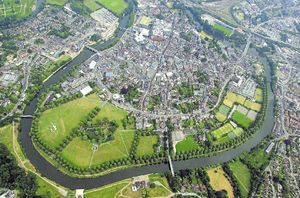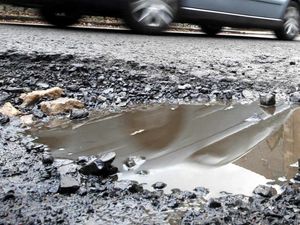Shrewsbury North West Relief Road: ‘Where’s the money gone Mr Grayling?’
Shropshire Council leader Peter Nutting has written to Transport Secretary Chris Grayling about the Shrewsbury North West Relief Road. Here is his letter in full.

"Dear Mr Grayling,
We are looking for Government support now for funding to support the delivery of the North West Relief Road for Shrewsbury.
The Shrewsbury North West Relief Road (NWRR) will provide a new, single carriageway road linking the northern and western parts of Shrewsbury.

It is the missing link in the county’s strategic highways infrastructure plan and will provide a new bridge over the River Severn and its flood plain, a new bridge over the Shrewsbury-Chester railway line and will complete a longstanding and important ambition to provide strategic highways infrastructure that will unlock growth potential and underpin the ambition to deliver significant regeneration within the historic county town.
It will connect existing roads with new roundabouts both on the local highway network and the strategic road network at the A5.
See also:
The end points of the NWRR have been determined by the existing Battlefield Link Road in the north, and the planned Oxon Link Road in the west. These roads were designed as precursors of a NWRR, and each provides access to important employment and development areas. The Oxon Link Road is included in the Marches LEP’s £75 million Growth Deal and will be delivered by 2021 as part of the proposed western sustainable urban extension.
In December 2017 Shropshire Council submitted a scheme outline business case (OBC) under the Department for Transport’s large local majors funding programme.
Our case for the NWRR follows published Department for Transport guidance and supports a funding request to the Department for Transport from Shropshire Council and Marches Local Enterprise Partnership.
It explains why the scheme should receive support, and provides a clear audit trail for the purposes of public accountability. It also explains how and why Shropshire Council has decided to put the scheme forward in its current form, and at the present time. It shows that the proposals are based on a careful consideration of options, a robust appraisal of costs and benefits, and a clear plan for delivering the scheme.
Links between the north and west of Shrewsbury are presently very poor. The most direct route passes close to the historic town centre through the “river loop” and consists entirely of single carriageway including residential and shopping streets. Congestion on these routes causes delays, pollution and makes journeys unreliable.
Weakness
Other problems arise directly from this fundamental weakness in Shrewsbury’s transport network. Noise, visual intrusion and poor air quality affect people in residential areas and the town centre, as well as people walking and cycling. Accident rates are higher on roads not designed to modern standards. Journeys to work and for business can be slow and unreliable, adding to the cost of transport, including public transport, and encouraging investment. As Shrewsbury continues to develop and grow, these problems are expected to get worse.
The NWRR will provide a new, high standard, direct route between north and west of Shrewsbury, offering big time saving for road users. For example, a peak hour journey from A5 Churncote to A49 Battlefield would take about six minutes using the NWRR, instead of about 20 minutes through the town centre of 15 minutes on the bypass. Traffic will therefore transfer from the existing routes, reducing congestion and making them more efficient.
These benefits will be experienced over a wider geographic area, including the outer bypasses and rural lanes, as well as the roads leading into and through the town centre. The NWRR will also help reduce accidents and carbon emissions, and will improve air quality in areas where people shop, work and live. It will give Shrewsbury a more efficient and resilient road network and support the town’s continued growth and economic development.
The cost of constructing the NWRR is estimated to be £71,399,500. Shropshire Council is asking for the Government to contribute a fixed sum of £54,406,419 from the DfT’s large local major schemes fund. Shropshire Council will provide the balance cost, estimated at £16,993,081, and accepts responsibility for any cost increases during the delivery phase.
During the period of the OBC preparation, the deadline for submission was brought forward considerably by DfT from March 31, 2018 to December 22, 2017. This was understood to be to allow consideration in advance of the 2018 Spring Statement. The challenge in accelerating the submission, in particular the onerous requirements for traffic modelling work, was considerable, but Shropshire Council and its consultants were successful in doing so.
Disappointing
It has been extremely disappointing therefore that there was no funding allocation announcement forthcoming either as part of, or at the same time as, the 2018 Spring Statement. The delay in this announcement beyond April 2018 now presents considerable challenges to the successful delivery of the NWRR scheme.
In order to meet the prescribed spend timetable and profile, the NWRR programme has been designed to move through design, planning and construction at some pace. This is achievable, but the success of the submitted programme is predicted on (in line with earlier DfT advice) being “in delivery” from April 1, 2018.
There are considerable amounts of preparatory work, including environmental survey work and ground survey work, that are seasonally specific and restricted, and as such, to not undertake these within 2018 would add a further 12 months delay to the planned delivery programme.
In order to meet the previously circulated programme timetables, Shropshire Council has agreed through its cabinet to work “at risk” in order to bridge the gap between the December 2017 submission and the expected April announcement. This is currently at a level of £190,000 of council revenue spend.
The permission to do so was agreed through the council’s cabinet in December 2017. There is now a concern that, due to any further delay in funding announcements, there will be a need to continue this “at risk” working. Given the current pressures on council funds at this time, there is a risk that members will not agree to such further work.
At this stage, the council may be forced to consider the withdrawal of the OBC and funding bid, as there is no way that the required programme for delivery could be met.
Given the local, and strategic significance of this piece of infrastructure, and the overwhelming support that the proposal has amongst the local business community, Local MP, Shropshire Council members, Shrewsbury Town Council, The Marches LEP, and the local population, this is clearly not something that Shropshire Council would consider lightly, however it may be an unfortunate necessity. "




